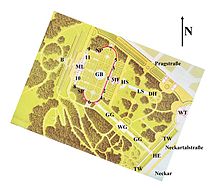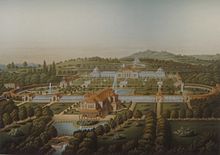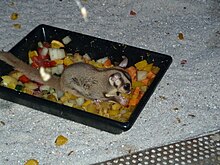Moorish country house
| Moorish country house | |
|---|---|
 |
|
| Data | |
| place | Wilhelma , Stuttgart |
| builder | Ludwig von Zanth |
| Client | Wilhelm I of Württemberg |
| Construction year | 1846 |
| Coordinates | 48 ° 48 '23.8 " N , 9 ° 12' 18.3" E |
The Moorish Country House is a former summer residence of King Wilhelm I of Württemberg in the Bad Cannstatt district of Stuttgart . The country house, built by court architect Ludwig von Zanth in the Moorish style in 1846 , is now used as a greenhouse and nocturnal animal house in the Wilhelma zoological-botanical garden .
history
In 1837 King Wilhelm I of Württemberg commissioned his architect Karl Ludwig von Zanth to design buildings in the Moorish style for his Wilhelma garden in Cannstatt . After mineral springs were found in the park of the neighboring Rosenstein Castle , a bathhouse with orangery was to be built first. After a few financing difficulties and planning changes, the Moorish country house was ultimately built as a residential building with adjacent greenhouses and a corner pavilion each and completed in 1846.
The entire complex was planned in such a way that the king could reach all important buildings without getting his feet wet. From the viewing pavilion on the Neckar (today's main entrance to Wilhelma) one could get through the greenhouses to the central winter garden and then through a covered walkway with a tiled wall and an arcade into the country house. From the country house one reached the Moorish Festsaal, which has not been preserved, via another gallery, and the Wilhelma Theater through the terracotta wall gallery .
The entire facility was completed in 1864. Initially only the royal family had access, but from 1880 the public could also visit the garden with an appropriate authorization card. After King Wilhelm II of Württemberg abdicated in 1918, the complex fell to the People's State of Württemberg , which was dissolved in the state of Baden-Württemberg in 1952 . The Moorish country house was restored in 1971 after being destroyed during the Second World War and restored in 2002.
The name "Moorish country house" is occasionally only related to the central part of the building, which was used as a residential wing for a long time. However, even in the time of Wilhelm I, the central building was framed on both sides by greenhouses, each of which ended in a glass dome. Today the entire structure is usually referred to as a Moorish country house.
Todays use
Today, Wilhelma's Moorish country house is used as a greenhouse, which included five individual rooms and, until 2014, also a nocturnal animal house. From a botanical point of view, the entire building includes five self-contained plant houses. From south to north these are the glass dome house with the tree ferns, the glass house with the tropical ferns, the central building with tropical plants and the nocturnal animal department, the glass house with the tropical crops and the glass dome house with the cacti. The five plant houses house over 1000 tropical and subtropical plants representing more than 350 species.
Tree fern house
The cold fern dome house houses large tree ferns with spreading leaves and horsetail ( Equisetum ), which also belong to the fern plants . Naked samos from the southern hemisphere such as araucarias ( Araucaria ), kauri trees ( agathis ) and stone slices ( podocarpus ) are also shown. A specialty is the wollemia ( Wollemia nobilis ) , which was only discovered in Australia in 1994 .
Fern warm house
In Farnwarmhaus thrive numerous tropical ferns such as Asplenium ( Asplenium ), maidenhair ferns ( Adiantum ) or epiphytes such platycerium ( Platycerium ). In addition to the ferns also grow Selaginella ( Selaginella ) and club mosses ( Lycopodium ) and cycads of the genus Cycas , Zamia and Lepidozamia .
Central building
Tropical plants from all continents are shown in the central building today. The violin fig ( Ficus lyrata ), the breadfruit tree ( Artocarpus altilis ), the trunk overgrown with bromeliads (Bromeliaceae) and the group of banana trees ( Musa ) are striking here . The titan arum ( Amorphophallus titanum ) "La Diva", which is located there, achieved international fame, and its inflorescence held the world record with a height of 2.94 meters above ground. The plant, which is native to Sumatra, bloomed for the first time from October 20-22, 2005. During these three days, around 30,000 visitors came to the country house to admire the titan arum. Further blooms took place in July 2008 and June 2011.
There are also some tropical birds and the nocturnal animal section in the central building, which can be reached via a staircase from the upper gallery.
Crop house
Many useful plants can be found in the useful plant house , for example fiber plants such as cotton ( Gossypium ), sisal agave ( Agave sisalana ) or textile banana ( Musa textilis ) and starch suppliers such as yams ( Dioscorea ), cassava ( Manihot esculenta ) or rice ( Oryza sativa ). Next you will find there fruits - and obstliefernde plants such as pineapple ( Ananas comosus ), Mango ( Mangifera indica ) or star fruit ( Averrhoa carambola ), spice plants such as vanilla ( Vanilla planifolia ), pepper ( Piper nigrum ) or nutmeg ( Myristica fragrans ) and Luxury food plants such as coffee bush ( Coffea ), cocoa tree ( Theobroma cacao ) or tea bush ( Camellia sinensis ). You can also see useful plants there that provide colorings or perfume additives .
Cactus dome house
The plants in the cactus dome house come mainly from the North American Sonoran desert . This subtropical desert is geologically very old and has a large variety of cacti . In addition to the large columnar cacti ( Pachycereus pringlei ), there are various types of opuntia ( Opuntia ) and agaves ( Agave ) as well as the still very original Pereskia ( Pereskia ). There are also dragon tree plants such as Beaucarnea and Dasylirion , pineapple plants such as Hechtia and Dyckia and the jojoba plant ( Simmondsia chinensis ), the supplier of the jojoba oil.
Nocturnal animal department
The nocturnal animal department was opened in 1962 and for the first time showed nocturnal animals in a European zoo, whose day-night rhythm was shifted by twelve hours with the help of artificial light. In addition to small mammals such as mouse lemurs ( Microcebus ), African Bilchen ( Graphiurus ) and Gleithörnchenbeutlern ( Petaurus ) and Fledertieren as Seba's short-tailed bat ( Carollia perspicillata ), Egyptian fruit bat ( Rousettus aegyptiacus ) and Indian giant flying fox ( Pteropus giganteus ) are also nocturnal water dwellers like Surinam toads ( Pipa ), glowing fish (Phosichthyidae), giant salamanders (Cryptobranchidae) and the axolotl ( Ambystoma mexicanum ) can be seen. The nocturnal animal department was closed in 2014.
literature
- Adrienne Braun: In the middle and outside. Stuttgart's quiet corners. Konstanz 2014, pages 42–46.
Web links
- Moorish country house , Wilhelma Zoological-Botanical Garden Stuttgart
Individual evidence
- ↑ a b c d e Moorish country house. Wilhelma Zoological-Botanical Garden Stuttgart, accessed on May 24, 2012 .
- ↑ Historical Buildings. Wilhelma Zoological-Botanical Garden Stuttgart, accessed on May 24, 2012 .
- ^ History of Wilhelma - 19th century. Wilhelma Zoological-Botanical Garden Stuttgart, accessed on May 24, 2012 .
- ↑ a b Fern houses. Wilhelma Zoological-Botanical Garden Stuttgart, accessed on May 24, 2012 .
- ↑ Moorish country house. Wilhelma Zoological-Botanical Garden Stuttgart, accessed on May 24, 2012 .
- ↑ Titan Arum data and facts. (No longer available online.) Wilhelma Zoological-Botanical Garden Stuttgart, archived from the original on March 8, 2013 ; Retrieved May 24, 2012 . Info: The archive link was inserted automatically and has not yet been checked. Please check the original and archive link according to the instructions and then remove this notice.
- ^ Tropical crops. Wilhelma Zoological-Botanical Garden Stuttgart, accessed on May 24, 2012 .
- ↑ Cactus dome house. Wilhelma Zoological-Botanical Garden Stuttgart, accessed on May 24, 2012 .
- ↑ Small mammals and nocturnal animals. Wilhelma Zoological-Botanical Garden Stuttgart, accessed on May 24, 2012 .
- ↑ The small mammal and bird house as well as the nocturnal animal section will close soon. Wilhelma Zoological-Botanical Garden Stuttgart, October 23, 2014, accessed on March 27, 2015 .







